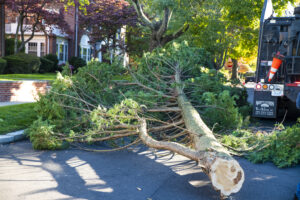Are you worried about the impact of storms on your trees? This article on storm preparation for trees includes everything from routine inspections and trimming to tree removal, assisting you in protecting your home and maintaining the health of your trees.
Damage to Trees by Storms
Storms may cause tree damage in various ways, depending on the kind and intensity of the storm. Some common ways that storms can damage trees include:
Wind gusts: Strong winds can cause branches to break, trees to uproot, and the canopy to become crooked or deformed.
Hail storms: Hail may harm a tree’s leaves, bark, and branches, making it more susceptible to disease and insect infestations.
Heavy snow or rain: Excessive rain or snow can saturate the soil surrounding a tree, increasing its susceptibility to tumble in high winds or other harsh weather. Strong winds or rain can uproot trees or weigh down branches.
Lightning strikes: Lightning strikes can split or even set fire to trees. A lightning strike can leave a tree with a burned or blackened trunk or branches or break the tree in half.
Ice storms: When the ice layer covers a tree’s branches and trunk during an ice storm, the weight of the ice might cause the tree to collapse.

All about Storm Preparation
You can take several steps to protect trees against storm damage and lessen the extent of damage, such as:
Inspect trees frequently: Before a storm comes, routine inspections might assist in locating possible threats. Examine the tree for damage indicators, such as fissures in the trunk, dead or broken branches, or indications of disease or insect infestation.
Trimming: You should cut extra branches near your home, electrical wires, or other structures. In the event of strong winds or torrential rain, this can assist in guarding against property damage.
Hire a professional tree removal service: Remove dead trees since they are more prone to collapse or lose branches during a storm; dead or diseased trees can represent a considerable threat. Engaging a professional tree removal service is critical if you need trees removed.
They will have the appropriate tools and skills to remove trees properly without causing harm to your property or the trees around it.
Mulch around the base of a tree: Mulching around the bottom of a tree can help protect and keep its roots wet; this is especially useful during dry spells when the tree is more susceptible to storm damage.
Have a plan: If you live in a storm-prone location, plan for what to do in the case of severe weather; this should contain a strategy for evacuating and a plan for protecting your property and trees.
Preparing your trees for storm season will help protect your property while keeping your trees healthy and growing. Your trees should be prepped and ready for whatever Mother Nature throws them. Remember that some preparation may go a long way when safeguarding your house and trees.